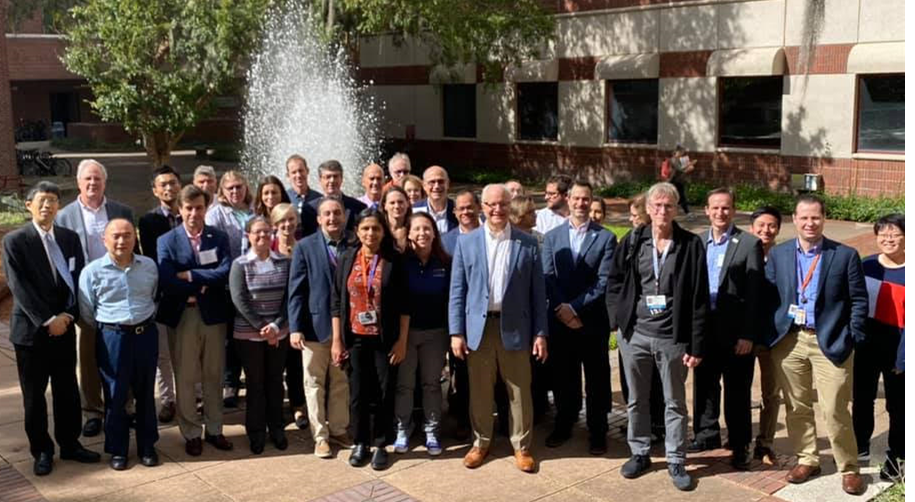On November 12th, 2019, the 10th “Tyler’s Hope Think Tank” took place at the University of Florida, USA. This year around the topic of “DYT-TOR1A dystonia: Finding a road map to cure dystonia”. This meeting and the Tyler’s Hope Foundation are initiatives from the Staab family. The two eldest Staab children, Tyler and Samantha, developed generalized dystonia as young children. Tyler’s was so severe that he was (at the time) the youngest ever child to receive surgery for deep brain stimulation in the USA. The children are now at university, and the “Tyler’s Hope Foundation” continues to work with neurologists at the University of Florida to raise funds for dystonia research, and to optimize clinical care.
The meeting opened with a tour of the new Norman Fixel Institute for Neurological Diseases outpatient clinic at the University of Florida in Gainesville, the same town where the Staab family live. The building was architecturally designed for patients to attend clinic with their families. It integrates different specialties in one building: a patient can see a Neurologist, DBS specialist, physiotherapist, and mental health doctor all in one visit. This was made possible by fund raising, and the long-term commitment of the University of Florida, especially Dr. Michael Okun, Chair of Neurology.
The Think Tank is a meeting for dystonia researchers. Many attendees commented on how critical it is that they get together to share their newest findings with each other. This year it was also attended by representatives from the USA National Institutes of Health, and the Dystonia Medical Research Foundation.
DYT-TOR1A dystonia is a major topic for basic dystonia researchers, even though it is a rare type of dystonia. This is because researchers know the genetic mutation, and therefore can study how this disrupts cell and brain function. The Tyler’s Hope Foundation focus on DYT-TOR1A dystonia because this is the type of dystonia in their family. DYT-TOR1A dystonia is notable because it was the first dystonia where a genetic cause was found. This discovery was made in 1999 by Dr. Laurie Ozelius (Harvard University). She attended the meeting as well, now 20 years after her seminal discovery. Its importance cannot be understated. It was the first absolute proof that genetic mutations can cause dystonia, in turn showing that dystonia has a real biological basis.
The first session was on the “Cellular effects of the torsinA protein”, with talks from Dr. Ellen Hess (Emory University, USA), Dr. David Standaert (University of Alabama, USA) and Dr. William Dauer (Southwestern University, USA). These researchers all work with mice that have been genetically engineered to carry the DYT-TOR1A mutation, and their research teams investigate what happens in the brains of these mice. All three groups are working towards a better understanding of what goes wrong in neurons when the TOR1A gene is mutated, with the expectation that this will point to new targets for drugs to treat the problem. The groups each presented data showing that a brain area called the striatum is affected. The striatum is a complex brain area that contains different types of neurons that release different chemical signals, and communicate with different brain areas. The researchers want to understand which specific neurons are affected. Dr. Dauer also focuses on *when* the problems first occur, and presented evidence that things go wrong in early brain development.
The second session was on the topic of “Gene therapy possibilities”. This is still at early stages for dystonia. Dr. Matthew Farrer (University of Florida, USA) explained why researchers focus on genetic forms of dystonia.
The genetic researchers also emphasized that some dystonia mutations cause different symptoms in different patients, and thus are not perfect predictors of what a patient can expect. They discussed the different ways that other genes and mechanisms interplay with a genetic mutation to determine symptom type and severity Dr. Ozelius and Dr. Farrer also both share the view that most dystonia mutations remain undiscovered to date.
The final session was “DYT-TOR1A dystonia: Novel treatment approaches”. I presented my team’s work on signaling abnormalities that we have identified in cells of patients, as well as in dystonia mice. This gives us a new so-called “druggable target”. The next steps are to find a drug that removes the abnormal signals. Dr. Nicole Calakos (Duke University, USA) talked about a specific stress-related molecular pathway that can help reduce dystonia related phenotypes, and how she is screening for new drugs.
The final talk was from Dr. Takashi Tsuboi (University of Florida, USA) who had reviewed patient records to identify factors that correlated with good and poor responses to deep brain stimulation.
Altogether, this was a very productive meeting for dystonia researchers. From all across the globe, scientists shared their results, showing real progress in our understanding of the biological mechanisms underlying dystonia. Exchanging data and thoughts is key to further push forward the many different research efforts taking place in individual laboratories.
Rose Goodchild, Ph.D.
Group Leader and Associate Professor
FDR Chair for Dystonia Research
VIB-KU Leuven Center for Brain and Disease Research, Belgium

Participants at the Tyler’s Hope Think Tank at the University of Florida, USA
